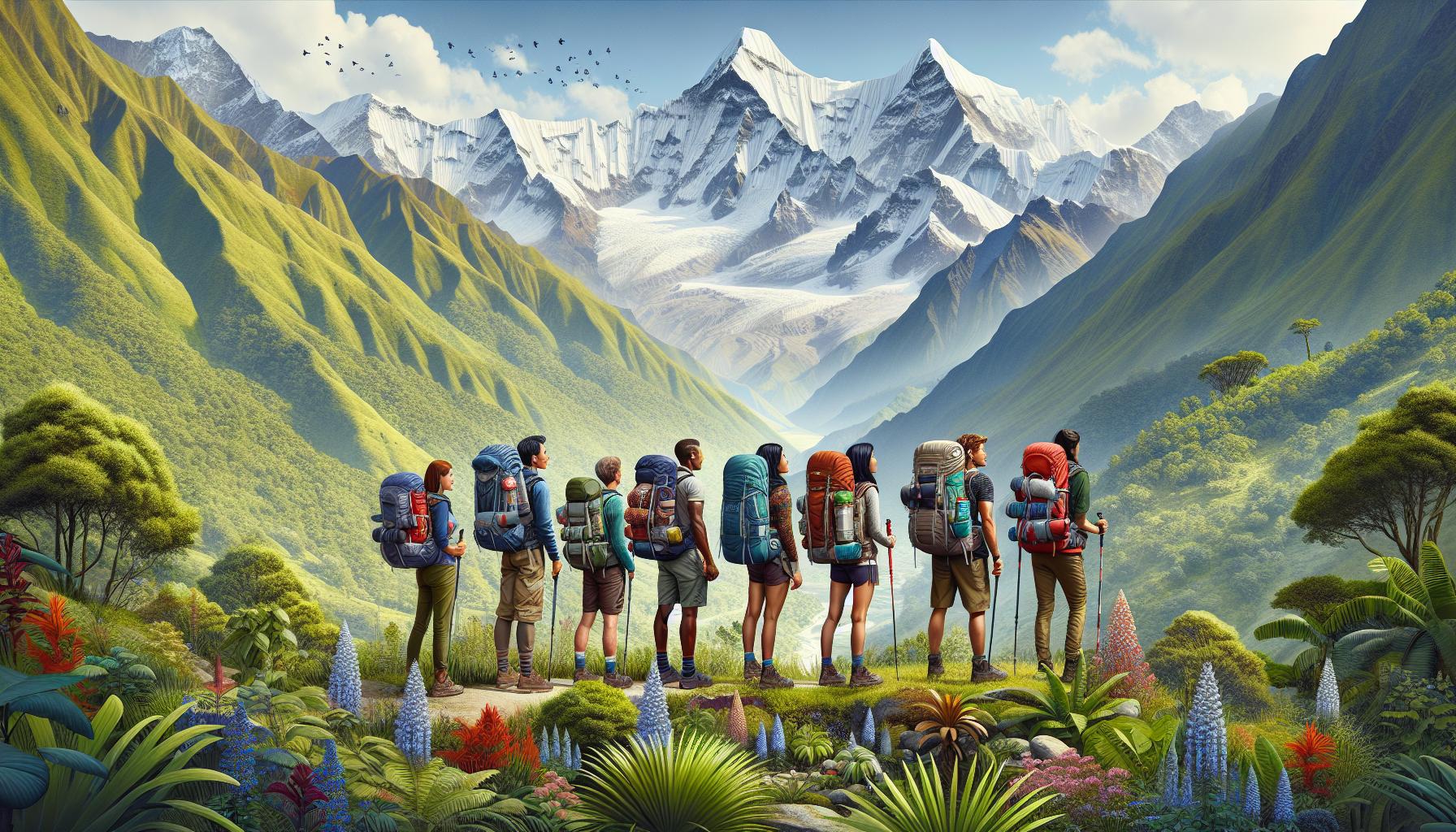Key Takeaways
- Adventure Paradise: Nepal is a premier destination for adventure tourism, featuring stunning landscapes and a variety of activities that cater to all skill levels.
- Popular Activities: Key adventure activities include trekking (Annapurna Circuit, Everest Base Camp), white-water rafting, paragliding, rock climbing, and bungee jumping, all offering unique thrills.
- Cultural Immersion: Engaging in adventure tourism allows travelers to experience rich local cultures and warm hospitality, enhancing the overall adventure.
- Economic Contribution: Adventure tourism significantly boosts Nepal’s economy, creating jobs and supporting local businesses while promoting sustainable practices.
- Environmental Responsibility: Responsible tourism is essential, with efforts to manage natural resources and protect the environment, such as banning single-use plastics in trekking areas.
- Safety First: Proper preparation, including essential gear, understanding local regulations, and acquiring necessary permits, is crucial for a safe and enjoyable adventure experience.
Nestled in the heart of the Himalayas, Nepal is a paradise for adventure seekers. With its breathtaking landscapes, towering peaks, and diverse ecosystems, it offers a playground for thrill-seekers from around the globe. From trekking the iconic Annapurna Circuit to white-water rafting on the raging rivers, Nepal’s adventure tourism scene is as vibrant as it is varied.
The country’s rich culture and warm hospitality add to the allure, making every expedition a unique experience. Whether it’s paragliding over Pokhara or scaling the heights of Everest, Nepal promises unforgettable adventures that cater to all levels of explorers. As travelers increasingly seek authentic and exhilarating experiences, adventure tourism in Nepal stands out as a top destination for those ready to embrace the wild.
Adventure Tourism In Nepal
Nepal serves as a top destination for adventure tourism, attracting thrill-seekers with its breathtaking landscapes and diverse activities. The towering peaks of the Himalayas provide unmatched opportunities for trekking, with routes like the Annapurna Circuit and Everest Base Camp trekking offering incredible views and challenges.
Adventure enthusiasts often engage in activities such as white-water rafting on the Bhote Koshi and Seti Rivers, where intense rapids create adrenaline-pumping experiences. Paragliding in Pokhara showcases another facet of adventure tourism, allowing travelers to soar above picturesque lakes and valleys.
Rock climbing and mountaineering remain popular, with numerous peaks challenging climbers of various skill levels. Bungee jumping at The Last Resort near the Tibetan border offers one of the highest jumps in the world, providing a unique thrill.
Cultural experiences also enrich the adventure, enabling travelers to connect with Nepalese traditions while exploring rugged terrains. Hospitality plays a significant role, with locals welcoming adventurers into their communities, enhancing the overall experience.
Overall, adventure tourism in Nepal presents an array of exhilarating activities set against stunning natural backdrops, making it an ideal choice for those seeking authentic adventure experiences.
Popular Adventure Activities

Nepal offers a thrilling array of adventure activities that attract tourists from around the globe. Here are some of the most sought-after experiences:
Trekking And Hiking
Trekking in Nepal showcases spectacular landscapes and diverse ecosystems. The Annapurna Circuit and Everest Base Camp treks attract trekkers with varied skill levels. These routes traverse lush forests, picturesque villages, and towering snow-capped peaks. Trekkers encounter unique flora and fauna, with opportunities to connect with local cultures. Guided treks enhance safety and provide insights into the region.
Rafting And Kayaking
Nepal’s rivers, such as the Bhote Koshi and Seti, offer thrilling white-water rafting and kayaking experiences. The Bhote Koshi river features class IV and V rapids, perfect for experienced adventurers. The Seti River offers gentler class II and III rapids for beginners. Adventurers can choose from day trips or multi-day expeditions, often combined with camping for a complete outdoor experience. Safety equipment and professional guides ensure an exhilarating yet secure adventure on the water.
Mountain Climbing
Mountain climbing in Nepal presents challenges for enthusiasts of all levels. Iconic peaks, including Annapurna and Lhotse, draw experienced climbers seeking high-altitude experiences. The region provides ample opportunities for technical climbing, with various guided expeditions available. Safety measures, including acclimatization protocols, are essential for successful ascents. Climbing in Nepal allows adventurers not only to test their limits but also to enjoy breathtaking mountain vistas throughout the journey.
Key Destinations For Adventure Tourism

Nepal boasts several key destinations that cater to adventure enthusiasts, each offering unique experiences amidst breathtaking landscapes.
The Annapurna Circuit
The Annapurna Circuit ranks among the world’s finest trekking routes. Spanning approximately 128 miles, this circuit provides trekkers with panoramic views of the Annapurna range, including Annapurna I, II, and III, as well as Dhaulagiri. Trekkers traverse diverse terrains, from lush subtropical forests to high alpine meadows, encountering vibrant local cultures along the way. The circuit typically takes 15 to 20 days to complete, allowing ample time to acclimatize and appreciate the stunning scenery.
Langtang Valley
Langtang Valley offers a less-traveled yet equally captivating trekking experience. Located near the Tibetan border, this valley features dramatic landscapes, including snow-capped peaks and deep valleys. The trek spans about 33 miles and takes roughly 7 to 10 days, showcasing the beautiful Langtang Lirung and Kyanjin Gompa. Trekkers can immerse themselves in the rich culture of the Tamang people, known for their unique traditions and hospitality.
Everest Base Camp
Everest Base Camp stands as one of the most iconic trekking destinations globally. This trek spans approximately 70 miles and takes about 12 to 14 days, leading adventurers to the foot of the world’s highest peak, Mount Everest. Along the route, trekkers experience stunning views of Everest, Lhotse, and Nuptse. The journey also offers encounters with local Sherpa culture and visits to vibrant monasteries, such as Tengboche Monastery. Safety measures and proper acclimatization practices ensure a secure yet thrilling adventure for all skill levels.
Cultural Impact Of Adventure Tourism

Adventure tourism significantly influences the cultural landscape of Nepal. As travelers engage with local communities, they create opportunities for cultural exchange and understanding while contributing to the preservation of traditions.
Economic Benefits
Adventure tourism generates substantial economic benefits for Nepal. It creates jobs in sectors such as hospitality, guiding, and transportation while supporting local businesses like shops and restaurants. In 2019, tourism accounted for 7.9% of Nepal’s GDP, with adventure tourism playing a crucial role in this figure. Local communities gain income through homestays and cultural experiences, promoting sustainable practices. Increased tourist visits foster investment in infrastructure, benefiting both locals and visitors. Overall, enhanced economic activity through adventure tourism contributes to regional development and poverty alleviation.
Environmental Considerations
Adventure tourism also brings environmental considerations to the forefront. The influx of trekkers and adventurers necessitates careful management of natural resources. Responsible tourism practices, such as waste management and conservation efforts, are critical. For instance, the Nepalese government banished single-use plastics in popular trekking areas to protect the environment. Additionally, many organizations promote eco-friendly tours that support environmental preservation. Balancing adventure activities with environmental sustainability ensures that Nepal’s stunning landscapes remain intact for future generations while fostering respect for local ecosystems.
Safety And Preparation Tips
Adventure tourism in Nepal requires proper safety measures and thorough preparation. Travelers should consider specific gear, familiarize themselves with local regulations, and understand the terrain for a secure and enjoyable experience.
Gear And Equipment
Travelers must equip themselves with appropriate gear for their adventures. Essential items include:
- Footwear: Sturdy hiking boots provide support and traction on various terrains, ensuring stability.
- Clothing: Layered clothing, including moisture-wicking base layers, insulating mid-layers, and waterproof outer shells, adapts to changing weather conditions.
- Backpacks: A comfortable, durable backpack accommodates essential supplies while distributing weight evenly.
- Sleeping Gear: A quality sleeping bag rated for cold temperatures enhances comfort during treks.
- Safety Equipment: Items such as first aid kits, headlamps, and multi-tools enhance safety and preparedness in remote areas.
Travelers may also consider specific gear based on activities. For instance, rafting requires helmets and life jackets, while climbing may need harnesses and climbing shoes.
Local Regulations
Understanding local regulations significantly enhances the adventure experience. Key regulations include:
- Permits: Trekkers must obtain necessary permits, such as the TIMS card and national park entry permits, before embarking on treks.
- Waste Management: Trekking areas enforce strict waste disposal guidelines to protect the environment. Travelers must carry out all waste, including non-biodegradables.
- Travel Insurance: Adequate travel insurance covering medical evacuation and trip interruptions remains advisable for personal safety.
- Respect for Culture: Visitors should familiarize themselves with local customs and practices, ensuring respectful interactions with communities.
Following these regulations promotes responsible travel and fosters positive relationships with local populations.
Premier Destination For Adventure Tourism
Nepal stands out as a premier destination for adventure tourism, offering an unparalleled blend of thrilling activities and rich cultural experiences. Whether trekking through the majestic Himalayas or navigating its exhilarating rivers, adventurers find themselves captivated by the stunning landscapes and warm hospitality.
The commitment to responsible tourism ensures that these breathtaking environments remain preserved for future generations while fostering respect for local traditions. With a diverse range of activities suitable for all skill levels, Nepal continues to attract thrill-seekers from around the globe, making it a must-visit location for anyone looking to unleash their adventurous spirit.